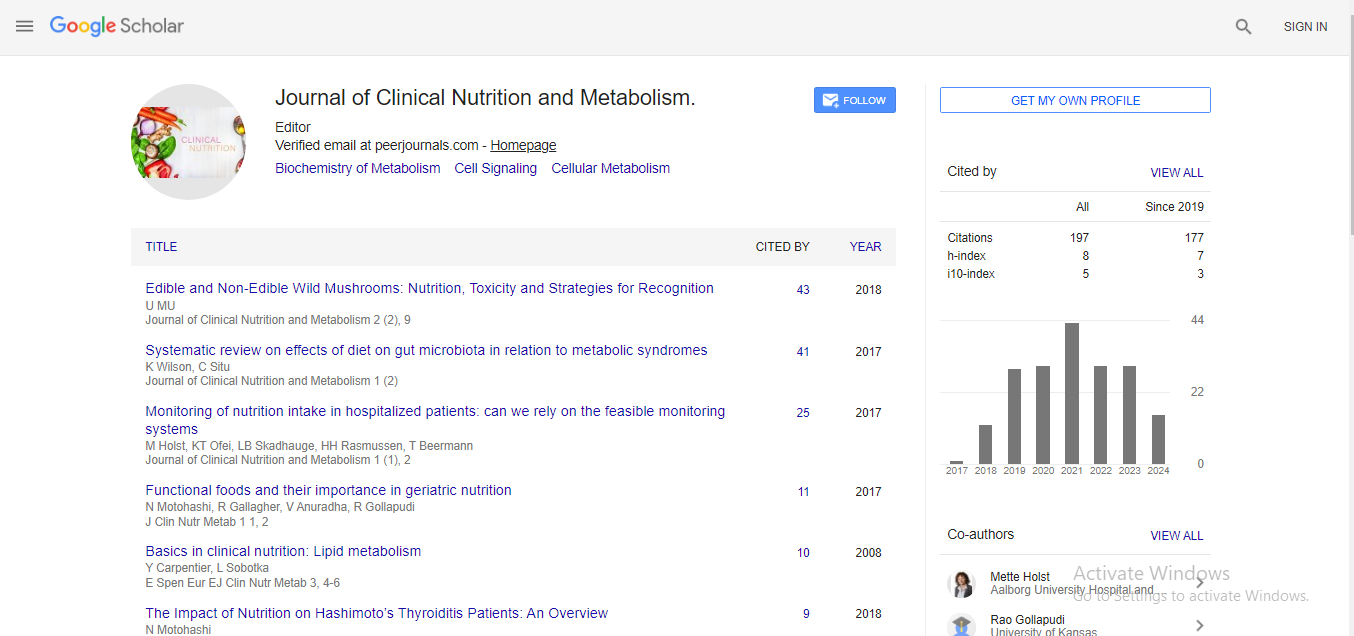Opinion Article, J Clin Nutr Metab Vol: 8 Issue: 4
Feeding the Future: The Evolution of Enteral Nutrition in Modern Medicine
Lisa Valarie*
1Department of Medical and Surgical Sciences, University of Bologna, Bologna, Italy
*Corresponding Author: Lisa Valarie,
Department of Medical and Surgical
Sciences, University of Bologna, Bologna, Italy
E-mail: lisa_valarie@oob.edu.it
Received date: 26 November, 2024, Manuscript No. JCNM-24-154786;
Editor assigned date: 28 November, 2024, PreQC No. JCNM-24-154786 (PQ);
Reviewed date: 12 December, 2024, QC No. JCNM-24-154786;
Revised date: 19 December, 2024, Manuscript No. JCNM-24-154786 (R);
Published date: 27 December, 2024, DOI: 10.35841/JCNM.1000161
Citation: Valarie L (2024) Feeding the Future: The Evolution of Enteral Nutrition in Modern Medicine. J Clin Nutr Metab 8:4.
Keywords: malnutrition
Description
Enteral nutrition is a priniciple of modern healthcare, providing essential nutrients directly to the GastroIntestinal (GI) tract when oral intake is insufficient or impossible. This method of feeding has revolutionized the management of malnutrition and the care of patients with complex medical conditions. As a cost-effective and physiologically sound approach, enteral nutrition preserves gut integrity and improves patient outcomes across a wide range of clinical scenarios. Enteral nutrition involves delivering nutrients directly into the digestive system through a feeding tube. This approach is indicated when patients cannot consume food orally but have a functional GI tract capable of digestion and absorption. The primary objective is to meet the patient’s energy and nutrient requirements to support recovery, maintain muscle mass prevent malnutrition. Additionally, enteral feeding helps maintain the structural and functional integrity of the GI tract, which is essential for overall health.
Nasogastric Tube (NGT) a short-term option for delivering nutrients into the stomach through the nose. Naso Jejunal Tube (NJT) used when feeding directly into the stomach is not possible, such as in cases of severe reflux or delayed gastric emptying. Gastrostomy a surgically or endoscopically placed tube for long term feeding directly into the stomach. Jejunostomy a tube placed in the jejunum, typically for patients with high risk of aspiration or upper GI tract obstruction. Bolus feeding administered at regular intervals, copying normal meal times. Specialized formulas are designed to meet the diverse needs of patients and address specific medical conditions. These are nutritionally complete formulas containing balanced proportions of carbohydrates, proteins, fats, vitamins minerals. They are suitable for patients with normal digestion. High-Calorie Formulas for patients with high energy needs or fluid restrictions.
Disease-Specific formulas adjusted for conditions like diabetes, renal failure, or respiratory disorders. These contain partially or fully hydrolyzed nutrients, designed for patients with malabsorption or severe digestive disorders. Some patients or caregivers opt for blenderized whole-food diets, which can be used with appropriate medical oversight. Compared to other methods of nutritional support, such as parenteral nutrition, enteral feeding offers distinct benefits.
Enteral feeding supports immune function, enhances wound healing reduces complications in critically ill patients. It is particularly beneficial for malnourished individuals, improving recovery and quality of life. Enteral nutrition is more affordable than parenteral nutrition, with fewer associated risks and complications. Enteral feeding minimizes the risk of catheter-related bloodstream infections, a common complication in parenteral nutrition. Patients may experience nausea, vomiting, diarrhea, or constipation. Adjusting the feeding rate, formula type, or administering prokinetic medications can help manage these issues.
Home Enteral Nutrition (HEN) with portable feeding systems and connected health support, patients can receive enteral nutrition in the comfort of their homes, promoting independence and quality of life. Formulas enriched with ingredients like omega-3 fatty acids, arginine nucleotides are being developed to support immune function in drastically ill patients. Increased interest in whole-food feeding has led to improved protocols and commercial availability of blended formulas for enteral use.
The successful implementation of enteral nutrition requires a multidisciplinary approach involving physicians, dietitians, nurses caregivers. A thorough nutritional assessment determines the patient’s energy, protein fluid needs. The choice of formula and feeding method is based on clinical condition, tolerance long-term goals. Regular monitoring of nutritional status, hydration feeding tolerance is Significant to avoid complications and ensure the effectiveness of the intervention. Training patients and caregivers in tube care, feeding techniques formula preparation is vital for adherence and preventing complications.
Conclusion
Enteral nutrition is a vital intervention in the management of patients with impaired oral intake. By providing nutrients directly to the GI tract, it supports recovery, prevents malnutrition improves overall outcomes in a wide range of medical conditions. While challenges remain, advancements in technology, personalized care home-based systems have enhanced the safety and accessibility of enteral feeding. As a physiologically sound and cost-effective approach, enteral nutrition will continue to play a key role in modern healthcare, ensuring that patients receive the nourishment they need to heal and develop.
 Spanish
Spanish  Chinese
Chinese  Russian
Russian  German
German  French
French  Japanese
Japanese  Portuguese
Portuguese  Hindi
Hindi 